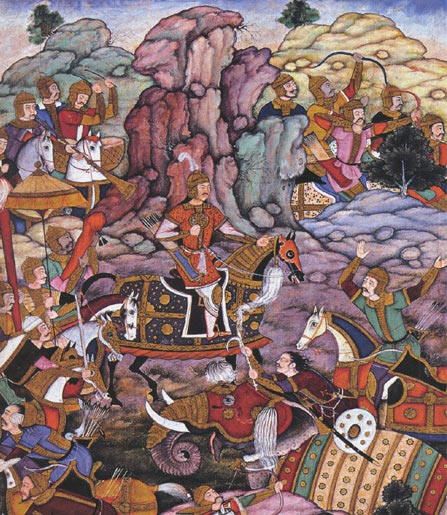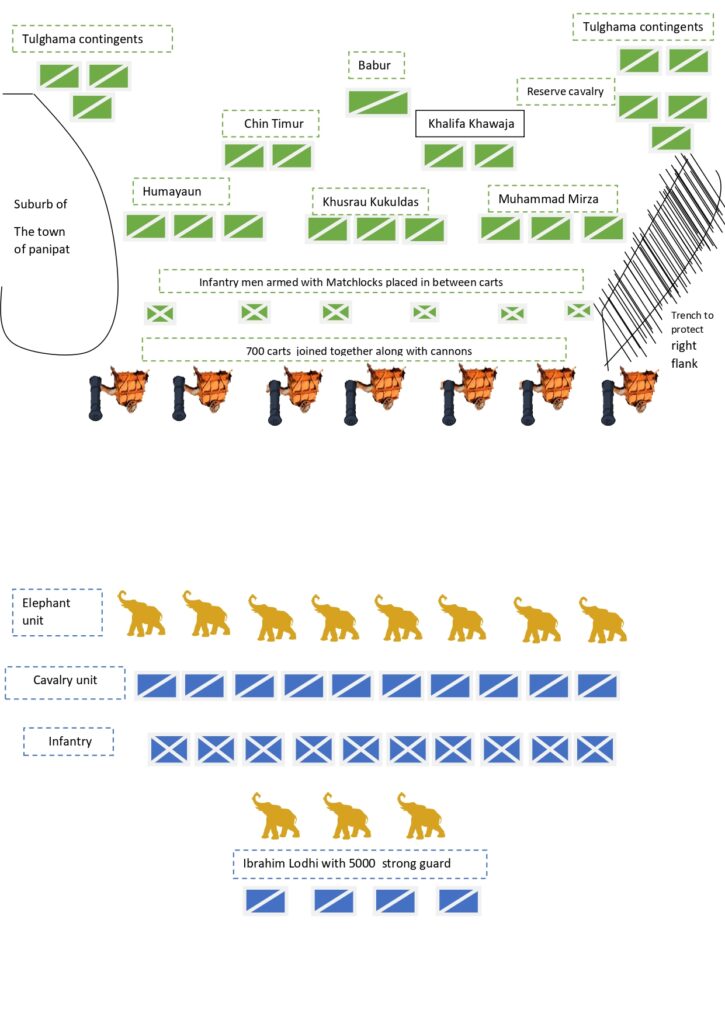Whether you like Mughals or hate them,everyone agrees that the influence that the Mughals have had on indian history is incomparable to any other invader. But how did the mighty mughal empire in India came to be formed. How Mughals entered India and how they extended their power are a long story. But it all starts with babur and the first battle of panipat.
Content
Background:
Zahir-ud-din Muhammed Babur was ruthless warlord who belonged to the Chagatai branch of the Turko – Mongol tribe. He was the 5th descendant of Timur on father’s side and 14th descendant of Genghis khan on mother’s side.
He became the ruler of Samarkand(a city in present day Uzbekistan) at the age of 11 but was quickly overthrown by an Uzbek warlord Shaibani khan.
In 1504, Babur was able to capture Kabul and several times he tried to conquer his homeland Samarkanda but failed every time. For raising money and to protect his conquered territories Babur turned towards Delhi Sultanate. This would eventually lead to him setting the mughal dynasty in India, being the main reason of how mughals entered India.
Ibrahim Lodhi was the sultan of Delhi sultanate at that time . But his sultanate was already in danger as the had already been defeated twice by another powerful Rajput king Rana Sanga. Internal rebellions were becoming common which gave Babur a chance to capture Delhi.

Babur plundered Bajaur, Bhira, Sialkot and continue to raid Indian territories till 1524. When the Mughals captured Punjab only then Ibrahim lodhi decided to prepare for a showdown battle in the field of Panipat.
Initial engagement
Daud khan, one of Ibrahim’s commanders advanced to delay the Mughal forces with 6000 men . The Mughals easily defeated the Afghans and took the surviving soldiers as prisoners. But on 5 April 1526 , to demoralize the enemy troops Babur ordered to kill every single prisoner and made a pyramid with their skulls in the same way as his ancestor Timur used to do.
Army Deployment
Ibrahim forces outnumbered the Mughal army at Panipat. He deployed elephant in front line cavalry in second and infantry in third. With 5000 strong rear composed of elephants, Ibrahim stayed in the rear.
Babur deployed his army with its right side protected by a suburb. Similarly to protect the left side he ordered his troop to dig a ditch protected by reserve cavalry unit of 200 armed with lethal crossbows.
To stop the cavalry charge from Ibrahim army, Babur arranged 700 carts and joined them to form a laager. Cannons were placed on the cart and between every two cart 6 matchlock tripod were set up to provide support for the matchlock men under Ustad Quli.

The right wing of the Mughals was commanded by Humayun(son of Babur) while Muhammed Mirza commanded the left and Khusrau Kukuldas commanded the advanced guard.
The cente of the Mughal was divided into two parts. The right under Chin timur and left under Khwaja.
The most important unit of the Mughal army was its Tulghama contingents which were basically flanking parties. Their main aim was to break the enemy flank and encircle the enemy center. This unit was deployed at the extreme right and left wing of the Mughal army under Qara Khazi.
Main Battle: Babur vs Lodhi
Ibrahim lodhi started the battle with his elephant and cavalry units from right and left. When they reached the Mughal right wing babur ordered his reserve cavalry unit to charge and Ibrahim lodhi attack came to a halt.
Immediately after it Babur gave order to attack his cannon and matchlock units to stop elephant advance. Frustrated from his initial move Ibrahim lodhi decided his to attack the Mughal left and right wings.
Lodhi troops were fighting without a proper strategic plan and were confused throughout the battle. Furthermore shots from the cannons combined with matchlock and crossbow archer caused heavy damage to lodhi troops.
To add more damage Babur launched his main strike force –The Tulghama contingents. They launched a lethal attack targeting lodhis flanks. Lodhi forces decided for a tactical retreat but it was too late for them.
Most of troops of the lodhi army were now concentrated in center. The mounted archers launched a rain of arrows on the central wing of Lodhi’s army which resulted in a massive slaughter.

Ibrahim lodhi decided to fight till the end died in the battlefield and thus ending a six hour long battle.
About 35000 soldiers of Ibrahim Lodhi were wounded and 15000 dead.
Reasons for defeat of Lodhis to Mughals
- Despite being smaller in size, Babur was able to come out victorious as he made excellent use of Field artillery ,probably for the first time in indian battle history. It not only killed men , but defeated the elephants in enemy army and caused havoc among the enemy lines.
- Baburs army used Gunpowder very effectively too.
- Lodhi troops were fighting without a proper strategic plan and were confused throughout the battle
- Mughals, being more war experienced, were tactically superior to Lodhis.
Importance of the first battle of Panipat for Indian History and how mughals entered India
First battle of Panipat resulted in the disintegration of Delhi Sultanate and establishment of the Mughal Empire in India. Mughal power grew throughout the century and was at peak during Akbar’s time. This foreign rule of Islamic fanatics bought great distress and misery to the indian people, who faced atrocities of all kinds and were forcibly converted to islam.
source: Wikipedia and various books.
Donate to our Cause
If you Support what we are doing and would like to contribute to help us grow and reach more Indians to teach them more about such forgotten historic Indian Heroes and stories, please consider donating any amount. It will help us grow


Send me notifications and mails and links which I can share on whatsapp.
Jai Maa Bharti
Share button is now active on the webiste